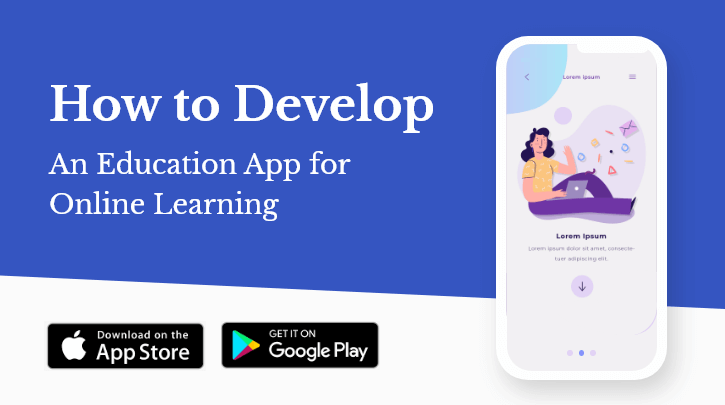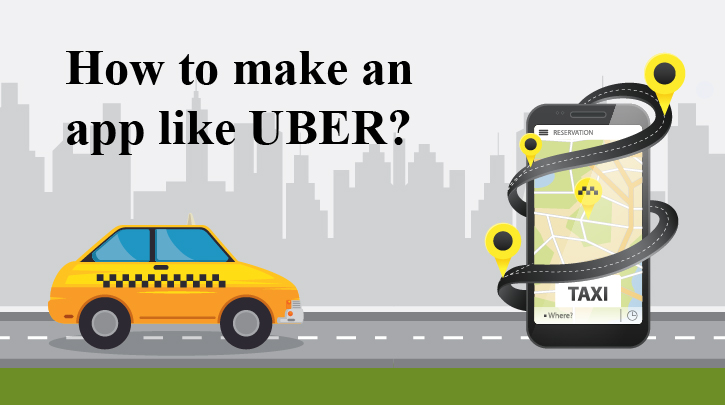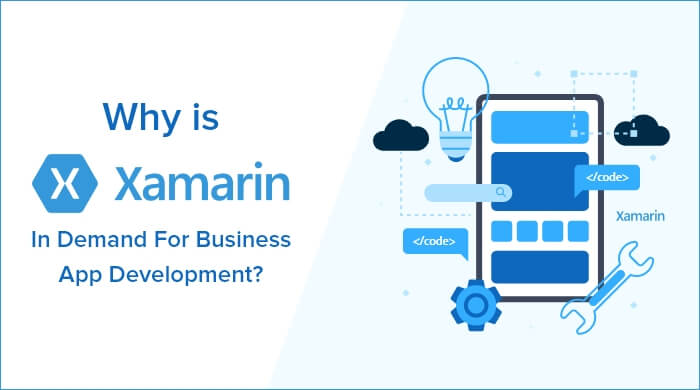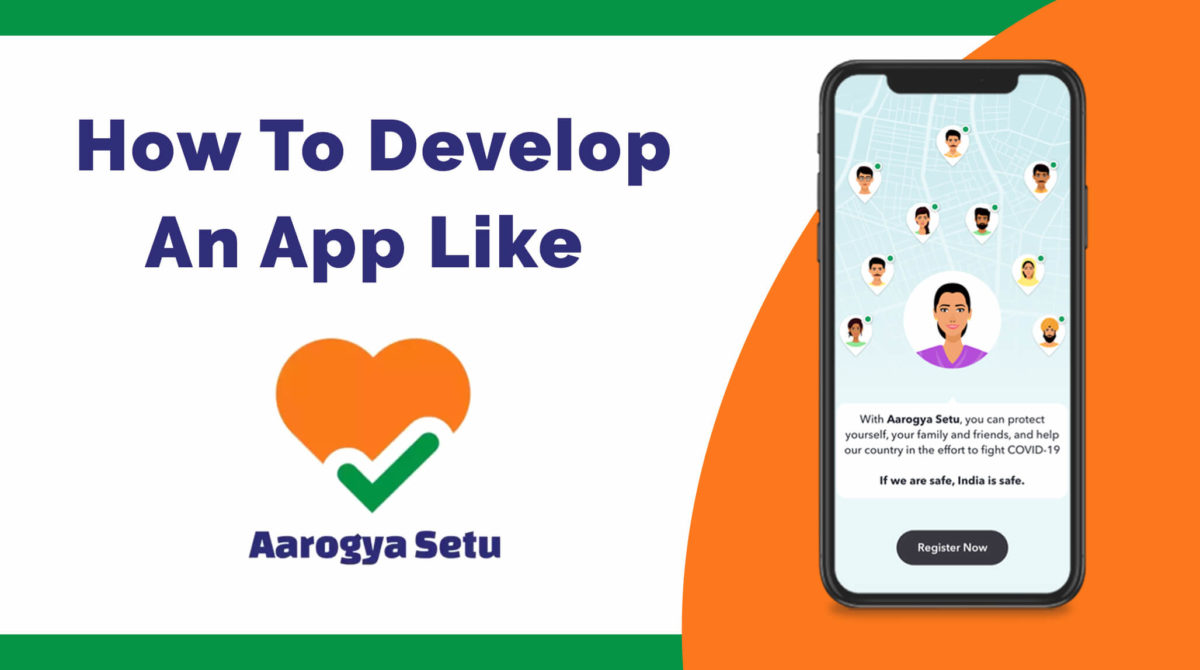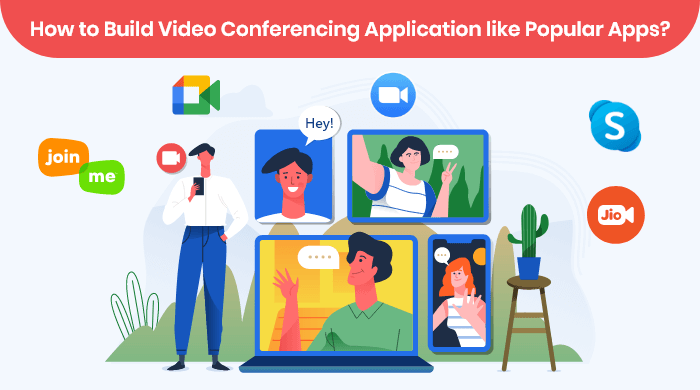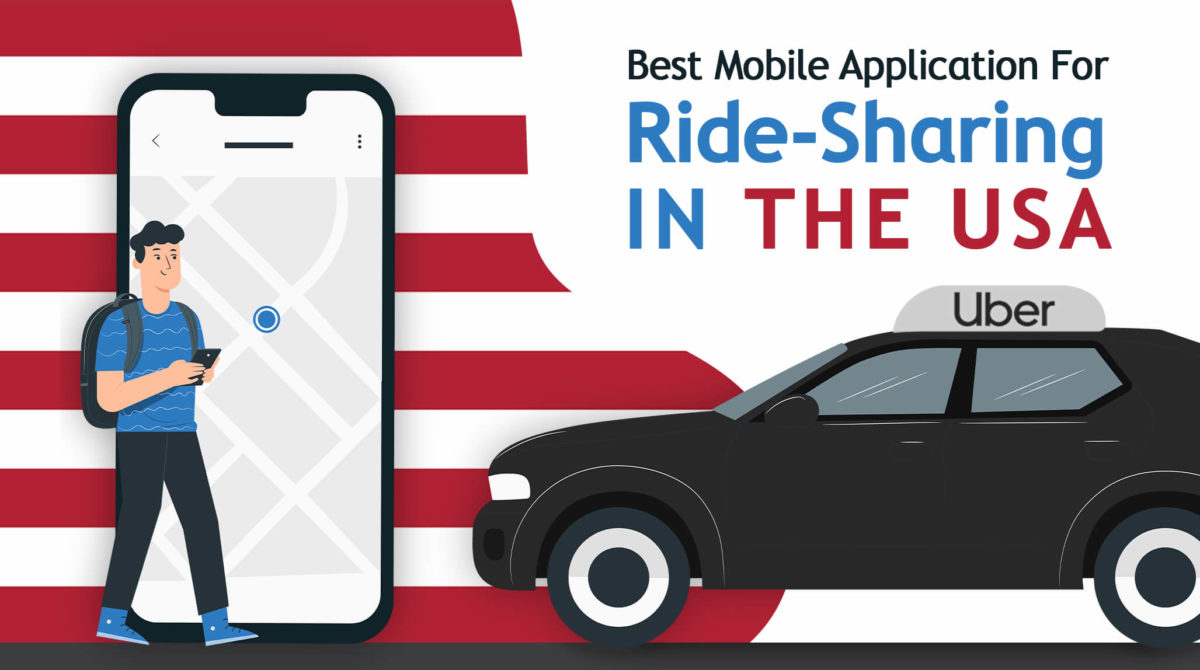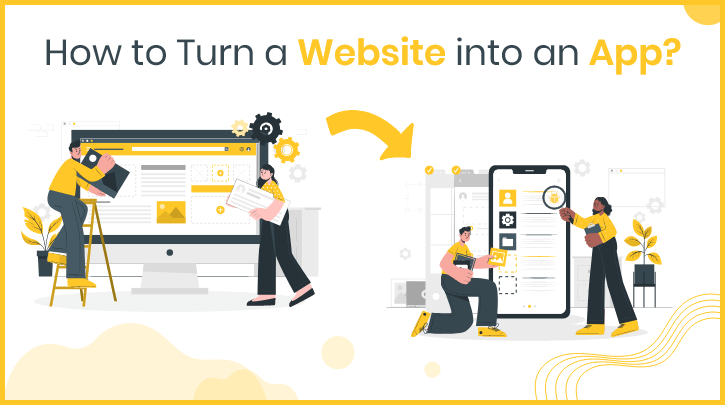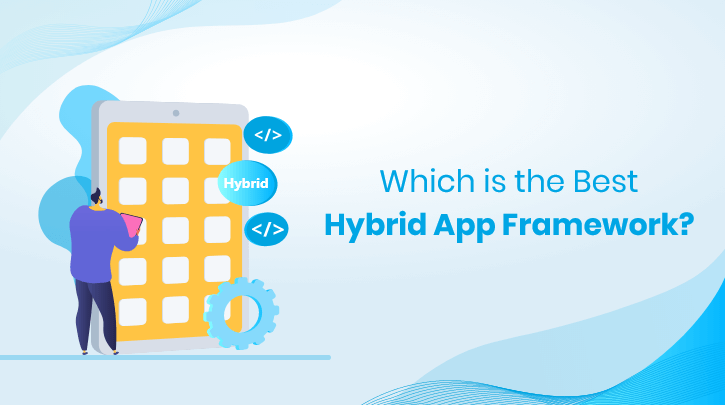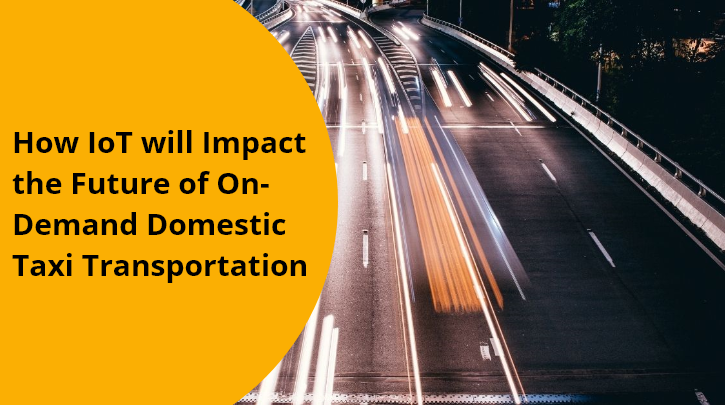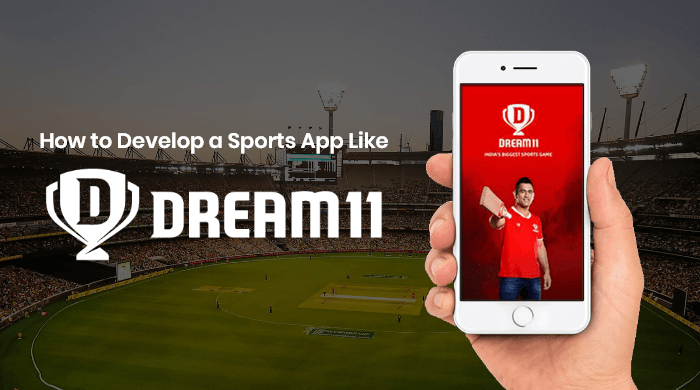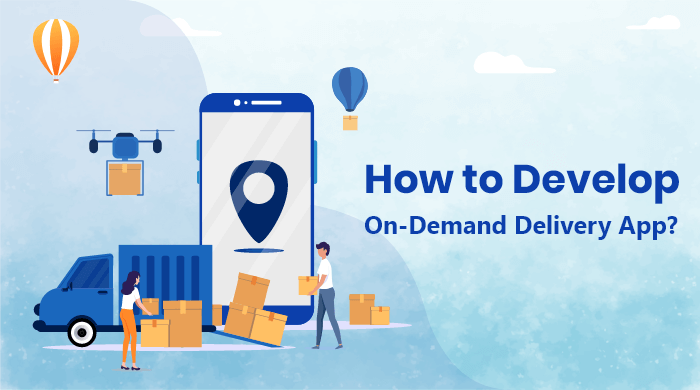
How to Develop an On-Demand Delivery App- Work Flow, Development Process, Cost Estimation
In the past few years, the popularity of on-demand delivery applications is expanding tremendously. Apps like Uber and Instacart etc. have become the next best discoveries in the market. And the current circumstances add more potential to online shopping, which has already been pushing the importance of such apps to new heights.
Also, the increased demand and competing in the mobile app industry, these apps are here to stay for a very long time. Whether it’s the courier delivery, food delivery, product delivery, or else, every business is giving on-demand apps a shot for a better reach and reputation in the market.
So, it becomes quite meaningful for everyone to understand what exactly makes these apps so popular among both business and the users.
What are the On-Demand Delivery Apps?
Apps which play a crucial role in completion of a demand being as an interface between two persons or enterprises are called On-Demand applications. There are two sides of the apps most of the time. One side is the user base who keeps on demanding the services and the other side can be an enterprise or another user base of service providers who accepts the request and completes it. Let’s understand how to develop an on demand app.
Types of On-Demand Delivery Apps
Around the world, every other company or business needs some kind of services that they can’t do themselves. Samsung Smartphones have Intel’s processor and Domino’s need the raw veggies supplier. Not to forget the common users who need many services on a daily basis like food delivery, transport, parcels and much more. Let’s know the broad classification of them.
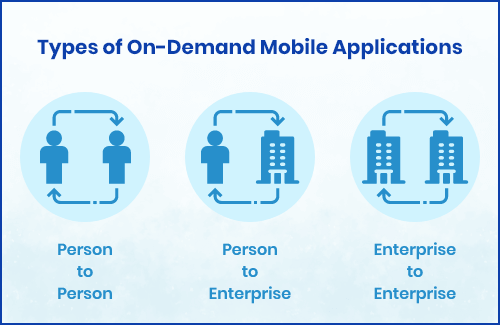
1. Person to Person
There are oftens very common services of people that can be completed by local service providers or common people. Here, the app is made by a third party company which acts as an interface between these two sides. Ride Sharing apps and Apps like Airbnb or Apps like Tinder are examples of this type.
2. Person to Enterprise
It is one of the most simple types of on-demand delivery apps where the enterprise creates an app to entertain the requests of their users through apps also. You can say this as a Business to Consumer App also. For Example an Online E-Pharmacy Store can be created for the needs of medicines and healthcare products in such times or for a restaurant company, Food ordering app is the kind of On demand app solution.
3. Enterprise to Enterprise
An Enterprise works on bigger projects and its every project may require services from a number of small vendors or businesses. For Example Walmart’s Suppliers have a customized application for tracking and management of their products.
Top Industries Where On-Demand Delivery app is a huge success
There are so many industries where this type of app is working but some of them have higher percentages of success than others. Let’s see what they are.
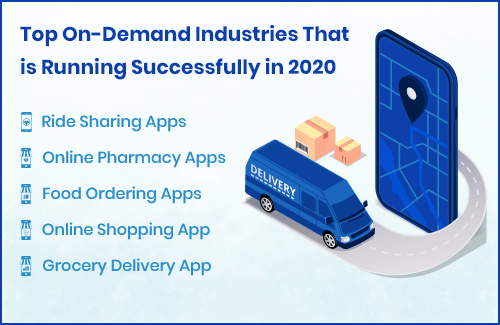
1. Ride Sharing Apps: Everybody knows Uber and its service of simplifying the transport. Ride Sharing apps are new and trending among the users.
2. Online Pharmacy Apps: This is the age of digital transformation and taking your services online is not just the trend but the necessity of the time. Leverage the potential of digital that can boost your business by bringing the business online like 1MG Pharmacy – the best healthcare online medicine provider in India.
3. Food Ordering Apps: Satisfying Hunger has generated millions of business around the world and the digitalisation of the service is now exponentially increasing the revenue of the Food Industry. Zomato, Swiggy are the prime examples of the online Food Ordering apps.
4. Online Shopping App: Technology is helping people live with a different level of comfort zone and Shopping is a hassle full task. These apps simplify shopping and give amazing experiences. Amazon is a popular example of such apps.
5. Grocery Delivery App: Not just fancy attires are delivered online but the daily essentials are also present online. On-Demand Delivery apps are a kind of opportunity that almost every business wants to leverage. BigBasket is a popular example of this.
Popularity of On Demand Delivery Apps
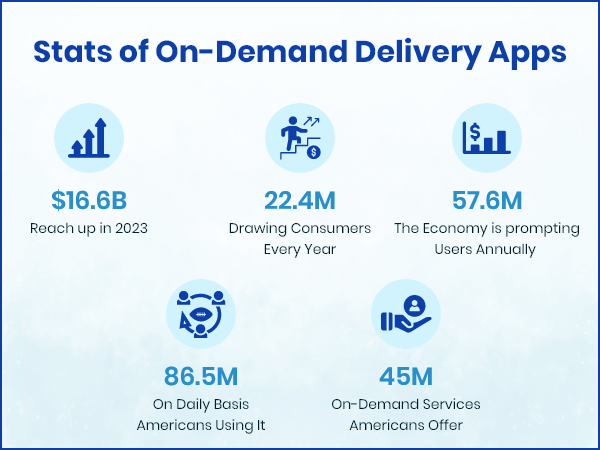
When it comes to on-demand delivery apps as per the latest research, the delivery of on-demand apps will reach up to $16.6B in 2023. Also, the food delivery market will be reaching up to 28% by 2023, which was around $3.7B in 2017. Drawing more than 22.4 million consumers every year, the on-demand app industry has annual average spending as $ 57.6 billion. So, if you are planning to build a delivery management app for your business, it is necessary to understand its competition and growing demand for the coming years.
How Does an On-Demand Delivery App Work?
The on-demand delivery app is inspired by private transportation and grocery supply companies that make shopping easier for the customers. Whether it’s enterprise to enterprise or enterprise to customer sort of application, the main goal is to fulfill the delivery needs of the end-user. Users get to order any service or product; they need and get it delivered. like beauty services, taxis, products, and so on. Here the user can be anyone ranging from a person to a business and the service provider can be a business or enterprise. The flow of the complete process is explained below in steps.
Step-Wise Working of the On-Demand Delivery app
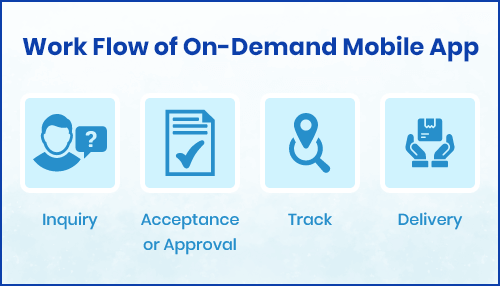
1. Inquiry
The person seeking some service puts an inquiry from the pool of service providers. The seeking method remains the same in almost all types of On-Demand Delivery apps.
2. Acceptance or Approval
The service provider can approve the request and deliver the service. Approver has the right to deny service if that can not be entertained at that moment. Denial is a common case in “Person to Enterprise to Person” type apps like Uber and Ola where drivers can deny the service but in ‘Person to Enterprise’ apps like McDonalds and Dominoes, denial is a rare case.
3. Track
Now, if your request has been approved, you can know all the time about what’s happening with it. In this complete process, you can also contact the service provider in some of the Person to Enterprise to Person apps. Tracking is a valuable part of on-demand service app features.
4. Delivery
This step is achieved when your requested service is completed or requested product has been delivered. It marks the completion of the process with another step remaining which is “Giving Review” but that step is not mandatory. Users have the choice to review the service provided by the app and person.
Must-Have Features of An On-Demand Delivery Application
If you include, customer’s app, admin’s web app panel, and driver’s app together, here are the must-have features for generic on-demand delivery applications.
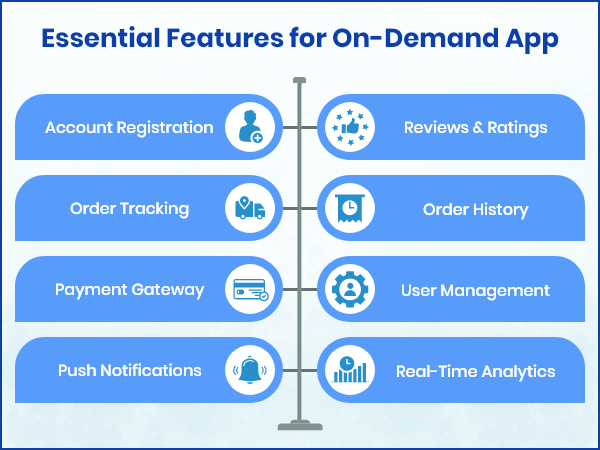
- Account Registration
Whether using a social media account or phone numbers, users can manage their accounts after a simple registration process with a secure information facility. This also helps businesses to maintain user data and insights for the app.
- Order Tracking
GRP tracking solution features help users to track their orders from time to time until delivered. This not only builds trust among users but ensures 100% customer satisfaction.
- Payment Gateway
Customers want to be able to pay easily with a secure payment gateway option without asking for too many details. Make sure you provide the most common payment options to let them complete the order.
- Push Notifications
Among the most important features of a delivery mobile app is the push notification that informs customers about the latest offers, orders, and essential alerts. This could be used as a brand recall option for start-ups.
- Reviews & Ratings
For both drivers and users, reviews and rating features can be a helpful medium to scale your business and make improvements accordingly. Customers can share their delivery and shopping experience, which help in business development in the long run.
- Order History
Order history and account setting features help users to check their previous orders and refund information if needed.
- User Management
Admin should be able to handle customers and delivery professionals’ activity along with discount, stock, and communication with the buyers regarding orders. A single dashboard or admin panel to handle user management helps maintain the business more efficiently.
- Real-Time Analytics
Real-time analytics allows the owner to track the progress of the services among the users. With analytics and graphs, admin can plan the business for better growth and improvement.
More features:
- Order Placement
- Scheduling Task
- In-App Payments
- Instant Chats
The list may get longer if you have a higher budget, but if you are looking for essential on demand delivery app features, each type of category may have these features to get positive results.
How to Develop the On-Demand Delivery App in 2020
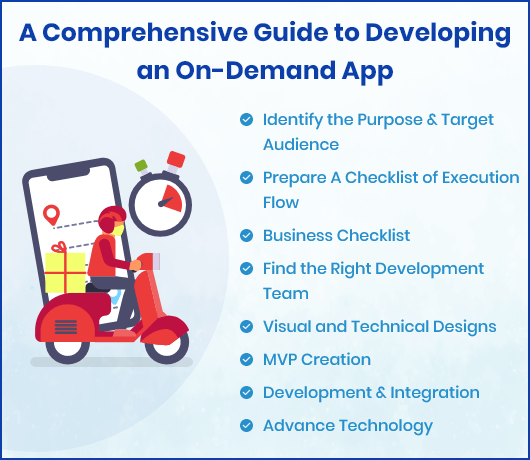
1) Identify the Purpose & Target Audience
Before you get into the complicated technical part, you need to verify that your idea satisfies your existing and potential customers with the on-demand app development plan. Get an online survey, research your competitors, and use social networking to find the right audience and their likes, dislikes.
Create a concept on paper, and the offering you are going to make with a mobile app. You can also take the help of existing apps on play stores that might give you an idea of how to make the most out of an on-demand app for your business.
2) Prepare A Checklist of Execution Flow
Once you are clear about your purpose, you will find it easier to create a checklist that your app development team will need from your end. Plan an execution flow which includes-
- Products, services, availability, catalogue company details.
- Order confirmation requirement from the user’s point of view.
- Feature list you want.
- Integration details.
- Prices, third party suppliers, and more.
- Development timeline/deadline.
3) Business Checklist
There are multiple types of on-demand delivery apps, ranging from food delivery logistics to flowers and gifts, and whatnot! So, moving an online business requires attention to detail related to your niche. Hence, you need to work on these KPI’s and find the best solution for your mobile app.
- Customer support service
- Discounts
- Suppliers and logistics
- Flexible hours
- Delivery charges
- Merchant information
- Legal authorities
- Security features
If you have collected all this information, you are ready to start with the technical responsibilities.
4) Find the Right Development Team
Now what comes next is to find the most suitable mobile app development company that offers experience, expertise, and specific results as you expect from start to finish. Research as much as you can and only work with developers who are skilled enough to meet the latest market requirements of an advanced on-demand delivery app.
5) Visual and Technical Designs
Ask your designers and developers to create a wire-frame so that they can create perfect UI/UX designs for your mobile app. Discuss your ideas and give feedback on the drafts, before it’s ahead for the development. It would be a great option to hire dedicated mobile app developers who understand how MVP ideation and user experience go together for successful on demand app development.
If you are not much into the technical part, trust your developers and keep yourself updated with the platforms, languages being used during the process.
6) MVP Creation
MVP or Minimum Viable Product is a ready to use app with the essential features of a mobile app, mainly created to gain early customers and examine the success of your on-demand delivery app. If you are not sure about investing your time and money into a full-fledged mobile app, you can get an MVP developed initially, and launch to test the success of your business idea. You can share the app with your stakeholders and get feedback for the final product development.
7) Development & Integration
After the MVP approval, the next and the most crucial step is to develop the actual application. While building an on-demand app for android or iOS, your developers implement the agile development techniques to the user several options and ensure that all the features that you want to integrate into the app are working properly. With testing at each step, the development process is finished once an in-house team tests the final product thoroughly, and fixes everything to ensure successful delivery.
8. Advanced Technology
Choosing any technology will decide the performance of your app and its ability to bear the growing number of users. With a large number of users, poor apps generally tend to break down but if you have consulted a technology company then the chances of breaking down are less. React Native can be used as the main developing language supported by following feature dependent technology.
Recommended Reading
How to Build an Educational App?
- For Payment – Braintree, Stripe, Paypal
- User location Finding – Google Places API
- Direction Finding – MapKit, Google Maps
- For Registrations – Facebook SDK, Gmail SDK
- For Storage – AWS, Google, Azure, Digital Ocean
- For Analytics – FireBase, Google Analytics
The base technology for the app can be any one from XAMARIN, REACT NATIVE, FLUTTER for the mobile app and for the backend development you can choose from LARAVEL, MEAN STACK, MERN STACK. If you need an hybrid app then you can choose any two technologies and combine their benefits to make a better one. ANGULAR is the most useful technology for front-end development.
How Much Does It Cost to Build an On-Demand Mobile App?
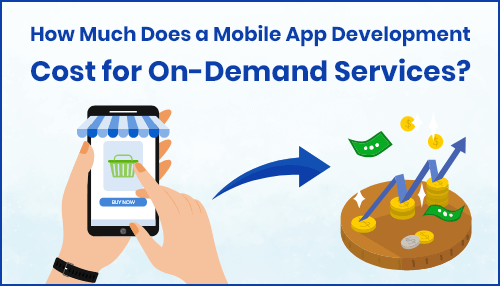
One thing that most people stress about is to decide the budget for developing on-demand mobile apps, especially when you are a beginner. Here is how you can plan your budget for on-demand apps for business.
Depending on the features and end-users, the cost depends on-
1) Customer’s app and features
2) Admin panel and web dashboard
3) Services and Integrations
Let’s assume you have hired a reputed app development company, the cost breakdowns in the following manner-
1) Initial purchase
2) Development Cost ($2000 to $40,000)
3) Platform (iOS/Android or both) Starting from $3000
4) User’s App Starting from $3000
5) Driver’s App (Starting from $4000)
6) Admin Panel ($1000)
7) MVP ($2000 To $5000)
Apart from these your features, category, and locations impact the overall cost of mobile app development.
If you are going with the fully-featured on-demand app, the cost may range from $10,000 to $80,000, depending on all the factors mentioned above.
Get the Best On-Demand Delivery App Development Services Here!
Now that you have gone through all the essential requirements, we assume you must be looking for a leading Mobile App Development Company that delivers as promised.
Maven Cluster is among the most trusted app development companies in India, serving a global clientele with advanced features and mobile apps on the system including Windows, Android, iOS, and web. We have a team that keeps upgrading the development techniques to deliver a successful mobile application suitable for your industry-specific requirements.

